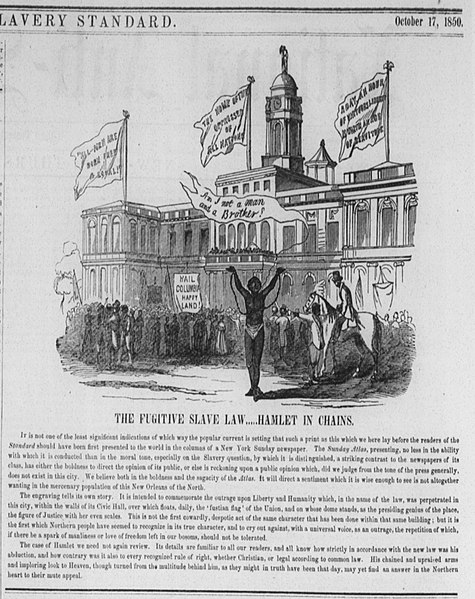Fugitive Slave Act of 1850
The Fugitive Slave Act or Fugitive Slave Law was a law passed by the 31st United States Congress on September 18, 1850, as part of the Compromise of 1850 between Southern interests in slavery and Northern Free-Soilers.
An April 24, 1851 poster warning the "colored people of Boston" about policemen acting as slave catchers.
Print by E. W. Clay, an artist who published many proslavery cartoons, supports the Fugitive Slave Act of 1850. In the cartoon, a Southerner mocks a Northerner who claims his goods, several bolts of fabric, have been stolen. "They are fugitives from you, are they?" asks the slaver. Adopting the rhetoric of abolitionists, he continues, "As to the law of the land, I have a higher law of my own, and possession is nine points in the law."
The Vicksburg Whig did not cite any sources for these claims about the number of fugitives from American slavery ("Slaves Escaping from the South", January 16, 1861)
James Hamlet, the first man re-enslaved under the Fugitive Slave Law of 1850, in front of New York City Hall. The banner on the right reads: "A day, an hour, of virtuous liberty is worth an age of servitude".
The Compromise of 1850 was a package of five separate bills passed by the United States Congress in September 1850 that temporarily defused tensions between slave and free states in the years leading up to the American Civil War. Designed by Whig senator Henry Clay and Democratic senator Stephen A. Douglas, with the support of President Millard Fillmore, the compromise centered on how to handle slavery in recently acquired territories from the Mexican–American War (1846–48).approved California's request to enter the Union as a free state
strengthened fugitive slave laws with the Fugitive Slave Act of 1850
banned the slave trade in Washington, D.C.
defined northern and western borders for Texas while establishing a territorial government for the Territory of New Mexico, with no restrictions on whether any future state from this territory would be free or slave
established a territorial government for the Territory of Utah, with no restrictions on whether any future state from this territory would be free or slave

The United States Senate, A.D. 1850 (engraving by Peter F. Rothermel): Henry Clay takes the floor of the Old Senate Chamber; Vice President Millard Fillmore presides as John C. Calhoun (to the right of Fillmore's chair) and Daniel Webster (seated to the left of Clay) look on.
Image: Compromise of 1850, (Page 1of 6) (5286033930)
Image: Compromise of 1850, (Page 2 of 6) (5286034754)
Image: Compromise of 1850, (Page 3 of 6) (5285438241)








